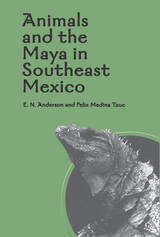3 books about Names, Mayan

Animals and the Maya in Southeast Mexico
E. N. Anderson and Felix Medina Tzuc
University of Arizona Press, 2005
In Mexico’s southeastern frontier state of Quintana Roo, game animals and other creatures that depend on old-growth forest are disappearing in the face of habitat destruction and overhunting. Traditionally, the Yucatec Maya have regarded animals as fellow members of a wider society, and in their religion animals enjoy the status of spiritual beings. But in recent years, the breakdown of cultural restraints on hunting has spiraled so far out of control that almost everything edible within easy reach of a road has become fair game.
This book combines the insights of an anthropologist with the hands-on experience of a Maya campesino with the aim of improving the management of Quintana Roo’s wild lands and animal resources. E. N. Anderson and Felix Medina Tzuc pool their knowledge to document Yucatec Maya understanding and use of animals and to address practical matters related to wider conservation issues.
This book combines the insights of an anthropologist with the hands-on experience of a Maya campesino with the aim of improving the management of Quintana Roo’s wild lands and animal resources. E. N. Anderson and Felix Medina Tzuc pool their knowledge to document Yucatec Maya understanding and use of animals and to address practical matters related to wider conservation issues.
Although the Yucatec Maya’s ethnobotany has been well documented, until now little has been recorded about their animal lore. Anderson and Medina Tzuc have compiled a wealth of information about traditional knowledge of animals in this corner of the Maya world. They have recorded most of the terms widely used for several hundred categories of animals in west central Quintana Roo, mapped them onto biological categories, and recorded basic information about wildlife management and uses.
The book reflects a wealth of knowledge gathered from individuals regarded as experts on particular aspects of animal management, whether hunting, herding, or beekeeping. It also offers case studies of conservation successes and failures in various communities, pointing to the need for cooperation by the Mexican government and Maya people to save wildlife. Appendixes provide an extensive animal classification and a complete list of all birds identified in the area.
Even though sustainable forestry has finally come to the Yucatán, sustainable game use is practiced by only a few communities. Animals and the Maya in Southeast Mexico is a complete ethnozoology for the region, offered in the hope that it will encourage the recognition of Quintana Roo’s forests and wildlife as no less deserving of protection than ancient Maya cities.
The book reflects a wealth of knowledge gathered from individuals regarded as experts on particular aspects of animal management, whether hunting, herding, or beekeeping. It also offers case studies of conservation successes and failures in various communities, pointing to the need for cooperation by the Mexican government and Maya people to save wildlife. Appendixes provide an extensive animal classification and a complete list of all birds identified in the area.
Even though sustainable forestry has finally come to the Yucatán, sustainable game use is practiced by only a few communities. Animals and the Maya in Southeast Mexico is a complete ethnozoology for the region, offered in the hope that it will encourage the recognition of Quintana Roo’s forests and wildlife as no less deserving of protection than ancient Maya cities.
[more]

Classic Maya Place Names
Edited by David Stuart and Stephen D. Houston
Harvard University Press, 1994
The authors present evidence that specific place names do exist in Maya inscriptions, and show that identifying these names sheds considerable light on both past and present questions about the Maya.
[more]

Place and Identity in Classic Maya Narratives
Alexandre Tokovinine
Harvard University Press
Understanding the ways in which human communities define themselves in relation to landscapes has been one of the crucial research questions in anthropology. Place and Identity in Classic Maya Narratives addresses this question in the context of the Classic Maya culture that thrived in the lowlands of the Yucatan peninsula and adjacent parts of Guatemala, Belize, and Western Honduras from 350 to 900 CE. The Classic Maya world of numerous polities, each with its own kings and gods, left a rich artistic and written legacy permeated by shared aesthetics and meaning. Alexandre Tokovinine explores the striking juxtaposition of similar cultural values and distinct political identities by looking at how identities were formed and maintained in relation to place, thus uncovering what Classic Maya landscapes were like in the words of the people who created and experienced them. By subsequently examining the ways in which members of Classic Maya political communities placed themselves on these landscapes, Tokovinine attempts to discern Classic Maya notions of place and community as well as the relationship between place and identity.
[more]
READERS
Browse our collection.
PUBLISHERS
See BiblioVault's publisher services.
STUDENT SERVICES
Files for college accessibility offices.
UChicago Accessibility Resources
home | accessibility | search | about | contact us
BiblioVault ® 2001 - 2024
The University of Chicago Press









